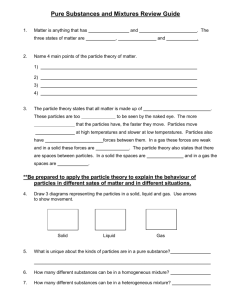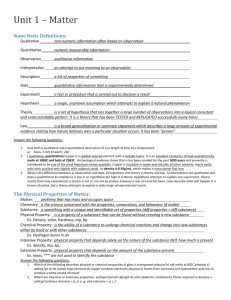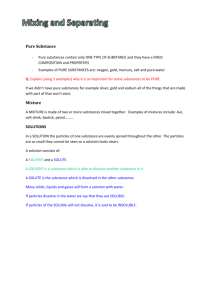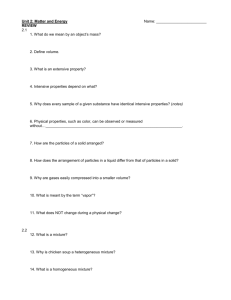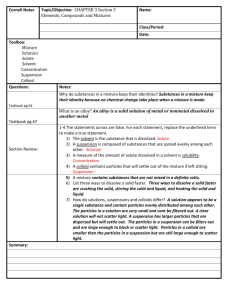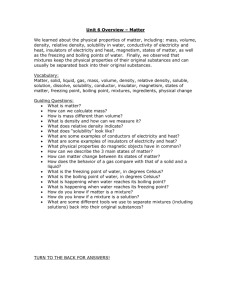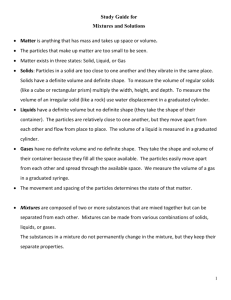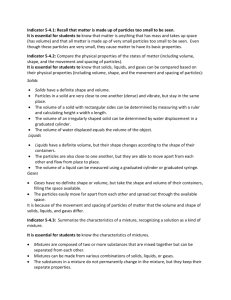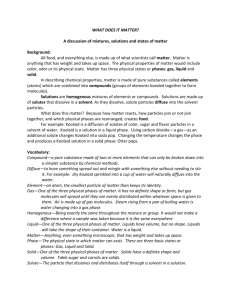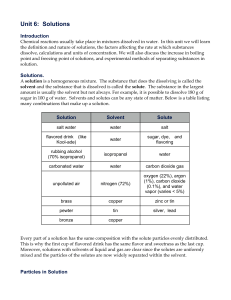Unit 5 Standards – Physical Behavior of Matter
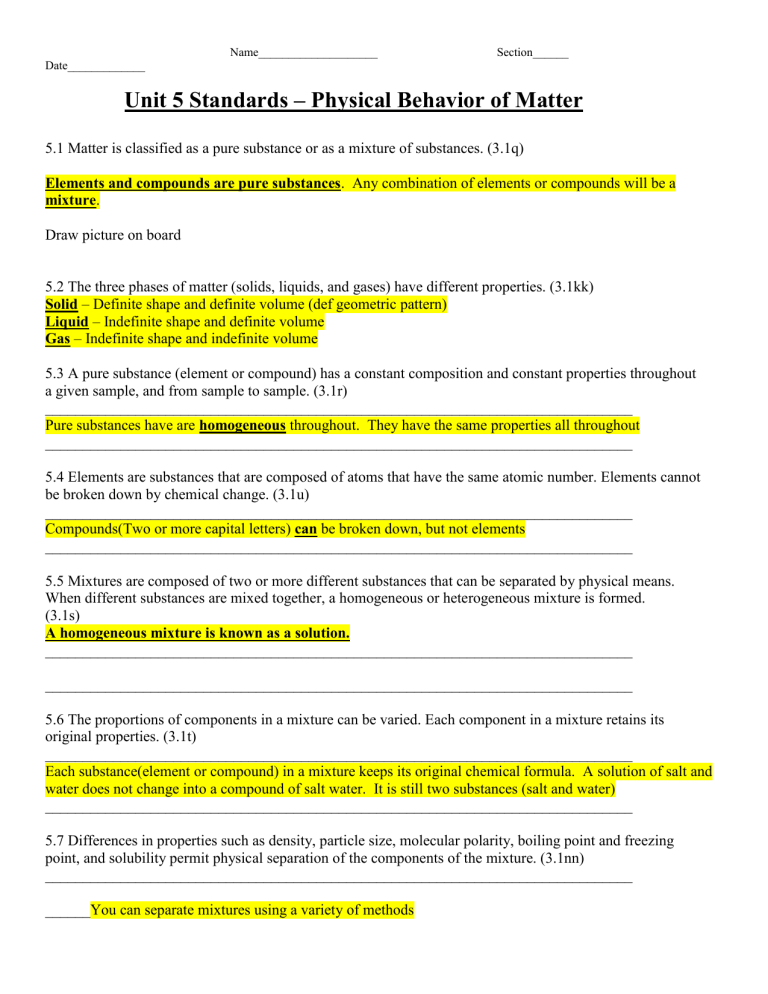
Name____________________
Date_____________
Section______
Unit 5 Standards – Physical Behavior of Matter
5.1 Matter is classified as a pure substance or as a mixture of substances. (3.1q)
Elements and compounds are pure substances . Any combination of elements or compounds will be a mixture .
Draw picture on board
5.2 The three phases of matter (solids, liquids, and gases) have different properties. (3.1kk)
Solid – Definite shape and definite volume (def geometric pattern)
Liquid – Indefinite shape and definite volume
Gas – Indefinite shape and indefinite volume
5.3 A pure substance (element or compound) has a constant composition and constant properties throughout a given sample, and from sample to sample. (3.1r)
______________________________________________________________________________
Pure substances have are homogeneous throughout. They have the same properties all throughout
______________________________________________________________________________
5.4 Elements are substances that are composed of atoms that have the same atomic number. Elements cannot be broken down by chemical change. (3.1u)
______________________________________________________________________________
Compounds(Two or more capital letters) can be broken down, but not elements
______________________________________________________________________________
5.5 Mixtures are composed of two or more different substances that can be separated by physical means.
When different substances are mixed together, a homogeneous or heterogeneous mixture is formed.
(3.1s)
A homogeneous mixture is known as a solution.
______________________________________________________________________________
______________________________________________________________________________
5.6 The proportions of components in a mixture can be varied. Each component in a mixture retains its original properties. (3.1t)
______________________________________________________________________________
Each substance(element or compound) in a mixture keeps its original chemical formula. A solution of salt and water does not change into a compound of salt water. It is still two substances (salt and water)
______________________________________________________________________________
5.7 Differences in properties such as density, particle size, molecular polarity, boiling point and freezing point, and solubility permit physical separation of the components of the mixture. (3.1nn)
______________________________________________________________________________
______You can separate mixtures using a variety of methods
________________________________________________________________________
5.8 A solution is a homogeneous mixture of a solute dissolved in a solvent. The solubility of a solute in a given amount of solvent is dependent on the temperature, the pressure, and the chemical natures of the solute and solvent. (3.1oo)
Table G is used to determine how much solute (hot chocolate) can be dissolved in water (solvent).
Table F is used to determine if a substance is soluble
______________________________________________________________________________
______________________________________________________________________________
5.9 The concentration of a solution may be expressed as molarity (M), percent by volume, percent by mass, or parts per million (ppm). (3.1pp)
______________________________________________________________________________
______________________________________________________________________________
5.10 The addition of a nonvolatile solute to a solvent causes the boiling point of the solvent to increase and the freezing point of the solvent to decrease. The greater the concentration of particles, the greater the effect. (3.1qq)
______________________________________________________________________________
The more salt(nonvolatile solute) you add to water the greater the increase in boiling point and decrease in freezing point
______________________________________________________________________________
5.11 Energy can exist in different forms, such as chemical, electrical, electromagnetic, thermal, mechanical, and nuclear. (4.1a)
______________________________________________________________________________
______________________________________________________________________________
5.12 Heat is a transfer of energy (usually thermal energy) from a body of higher temperature to a body of lower temperature . Thermal energy is the energy associated with the random motion of atoms and molecules. (4.2a)
______________________________________________________________________________
______________________________________________________________________________
5.13 Temperature is a measurement of the average kinetic energy of the particles in a sample of material.
Temperature is not a form of energy. (4.2b)
______________________________________________________________________________
______________________________________________________________________________
5.14 The concept of an ideal gas is a model to explain the behavior of gases. A real gas is most like an ideal
gas when the real gas is at low pressure and high temperature . (3.4a)
______________________________________________________________________________
______________________________________________________________________________
5.15 Kinetic molecular theory (KMT) for an ideal gas states that all gas particles (3.4b):
1. are in random, constant, straight-line motion.
2. are separated by great distances relative to their size; the volume of the gas particles is considered negligible.
3. have no attractive forces between them.
4. have collisions that may result in the transfer of energy between gas particles, but the total energy of the system remains constant.
______________________________________________________________________________
______________________________________________________________________________
______________________________________________________________________________
______________________________________________________________________________
5.16 Collision theory states that a reaction is most likely to occur if reactant particles collide with the proper energy and orientation. (3.4d)
______________________________________________________________________________
______________________________________________________________________________
5.17 Kinetic molecular theory describes the relationships of pressure, volume, temperature, velocity, and frequency and force of collisions among gas molecules. (3.4c)
______________________________________________________________________________
______________________________________________________________________________
5.18 Equal volumes of different gases at the same temperature and pressure contain an equal number of particles. (3.4e)
______________________________________________________________________________
______________________________________________________________________________
5.19 The concepts of kinetic and potential energy can be used to explain physical processes that include: fusion
(melting), solidification (freezing), vaporization (boiling, evaporation), condensation, sublimation, and deposition. (4.2c)
5.20 A physical change results in the rearrangement of existing particles in a substance. A chemical change results in the formation of different substances with changed properties. (3.2a)
______________________________________________________________________________
______________________________________________________________________________
5.21 Chemical and physical changes can be exothermic or endothermic. (4.1b)
______________________________________________________________________________
______________________________________________________________________________
5.22 The structure and arrangement of particles and their interactions determine the physical state of a substance at a given temperature and pressure. (3.1jj)
______________________________________________________________________________
______________________________________________________________________________
5.23 Intermolecular forces created by the unequal distribution of charge result in varying degrees of attraction between molecules. Hydrogen bonding is an example of a strong intermolecular force. (5.2m)
______________________________________________________________________________
Hydrogen bonding is FON
______________________________________________________________________________
5.24 Physical properties of substances can be explained in terms of chemical bonds and intermolecular forces.
These properties include conductivity, malleability, solubility, hardness, melting point, and boiling point.
(5.2n)
______________________________________________________________________________
______________________________________________________________________________

